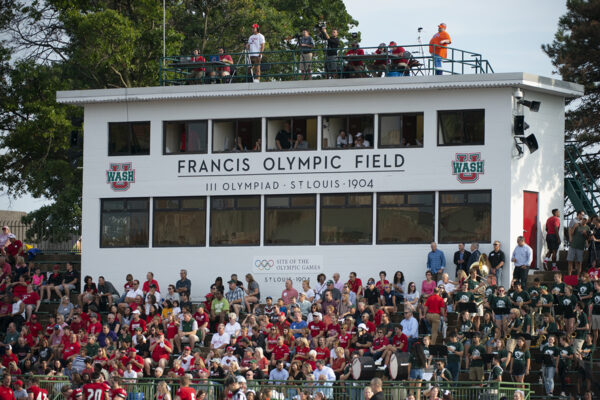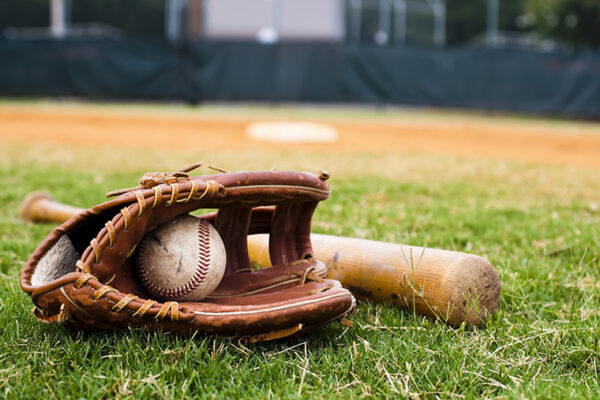A top-10 academic institution and a relatively small athletics budget, including no athletics scholarships — is this a recipe for success off the field? Yes, but on the field? It works for Washington University in St. Louis, a hotbed for Division III athletics.
 Ben Malcolmson, sports editor of The Daily Trojan at the University of Southern California, explores the athletic and academic success of Washington University, which has won 12 Division III national championships in the last 15 years, despite the innate differences within the realms of Division I and Division III athletics programs.
Ben Malcolmson, sports editor of The Daily Trojan at the University of Southern California, explores the athletic and academic success of Washington University, which has won 12 Division III national championships in the last 15 years, despite the innate differences within the realms of Division I and Division III athletics programs.
The article below, which originally ran Wednesday, March 24, 2004, is republished with permission from The Daily Trojan.
Division III Washington University passes up big money, big problems
By Ben Malcolmson
With the sun shining unusually bright and the air unusually balmy for this mid-March day, the Washington University baseball team took the field just like any other.
Only this wasn’t your normal team – or normal university athletic program.
This school’s teams face a unique challenge that no big-time university has ever faced or has ever wanted to face.
“It’s hard to match up a 1400 SAT and a skilled baseball player,” Washington University baseball coach Ric Lessmann said.
A 150-year-old private school situated in a tree-lined section of St. Louis, Division III Washington University doesn’t have athletic scholarships. The athletic department doesn’t get help from admissions for a star recruit. And the athletic budget might as well be pennies in comparison with those of some Division I athletic programs, including USC.
This is no normal athletic program.
“You’re talking about a different world between Division I and Division III,” Washington University Athletic Director John Schael said. “The priority here is on academics.”
Washington University’s teams can only recruit players who meet or exceed the school’s academic standards, which can be quite a difficult thing to do at a school where scoring 1400 on the SAT and finishing in the top 5 percent of your class is barely enough for you to be even considered for admission.
The admissions department of Washington University doesn’t grant the athletic program any leeway in terms of academic credentials for recruits and athletic scholarships are nonexistent at the Division III level, so it is pretty difficult to win.
“I don’t recruit related to baseball,” said Lessmann, who has coached 11 years at Washington University and 39 years total, compiling a 1,204-410-1 all-time record. “You have to go after them academically. I really sell the academics.”
But this isn’t the chess club suiting up and attempting to play ball.
The athletes at Washington University might be the ones performing surgery on you in 10 years, but they do not fit into the nerd stereotype. Of Washington University’s 18 varsity teams, only one has a losing record and 10 are reigning champions of the University Athletic Association, an athletic conference featuring “eight leading universities committed to academic and athletic excellence,” according to the UAA’s Web site.
Four of those 18 sports do not have UAA conference affiliation, so Washington University has a 71 percent success rate in conference championships during this previous year.
The women’s volleyball team won the NCAA championship in December and the women’s basketball team is only three years removed from four consecutive NCAA titles.
“Guys still have the competitive spirit,” senior first baseman Ryan Argo said. “We’re as competitive as Division I athletes.”
Getting in might be the most competitive part – more than 20,000 people apply each year for only 1,300 spots in the freshman class, so recruiting is a bear.
“If you don’t have a 1400 SAT, a 30 to 31 ACT and if you’re not in the top 5 to 7 percent of your class, I throw (the recruit’s interest form) in the waste can,” said Lessmann, who added that he has no influence in the admissions office like Division I programs allegedly do for players who do not meet the university’s academic criteria.
At a university where tuition runs at a USC-esque $41,000 a year, Lessmann’s pool of recruits shrinks after high school players learn of the rigid academic standards and the cost of attending the school.
“There are two hurdles: You’ve got to get in and what type of financial aid package are you going to get,” said Lessmann, who played in the New York Yankees’ minor-league system at age 17. “But, we don’t have tons of full-pay players. The average academic scholarship is from $10,000 to $11,000.”
Players are not the only ones hit with money woes. Washington University’s athletic department as a whole has to deal with a diminutive budget compared to the likes of USC’s and other major universities’.
The Washington University athletic department spent slightly more than $2 million during the 2002-03 school year, while USC’s athletic department spends nearly $47 million, 23 times more than Washington University, in that same time period. USC’s expenses for its 19 sports are about average for a major university’s athletic program with a similar number of sports (Notre Dame’s is $38.5 million; Texas’ $49.4 million; Florida’s $54.2 million).
“(USC is) in the money game and we’re not,” Lessmann said.
And consider that USC and Washington University have a similar number of athletes (593 for USC and 528 for Washington University), sports (19 and 16 teams, respectively) and operating expenses for their respective universities as a whole ($1.52 billion for USC and $1.35 billion for Washington University).
USC’s male head coaches, on average per position, were paid nearly seven-and-a-half times more than Washington University’s ($245,046 to $32,786).
USC’s operating expense for football is $1.96 million. Washington University’s is $106,519.
USC awarded $7.24 million in athletic scholarships for all of its sports in 2002-03. Washington University awarded $0.
What were you saying about the money game, coach Lessmann?
It’s all proof that money drives Division I athletics. And it’s all proof that academics drive Division III athletic programs.
But no one’s complaining at Washington University.
“(Division III) fits really well here because academic standards are so high,” Argo said. “There’s guys good enough to play Division I. It’s just a choice you make and everyone is happy with their choice. I haven’t met a single guy who wasn’t.”
Washington University has been ranked by many sources as one of the top-10 universities in the country, so these players put the student in student-athlete.
“Studies come first here,” said Argo, who is currently nursing a sprained thumb. But the injury “allows me to catch up on my studies,” the team captain said.
What a relief to hear something like that during a time in Division I college athletics in which female kickers are being raped, a coach is giving tests no one could fail and programs are frequently being caught for recruiting violations only Kobe Bryant could love.
Washington University athletics do not have the professional feel – the Bears don’t have a 92,000-seat football stadium or Nike swooshed on them from head to toe – that has become all too apparent in college sports these days.
“Here, we don’t have that attitude,” Argo said.
Not a single player has left for the NFL early at Washington University, nor has any player transferred because of animosity on the team.
No, at Washington University, a game is just a game, and the real reason these student-athletes are here has to do more with making millions in medicine or business or foreign affairs than in the NBA or MLB.
On that warm mid-March day, the Washington University baseball team lost, 5-2, to Elmhurst College, another small Division III school.
But, as Schael says, “the priority is on academics.” A win’s only a win and a loss is merely a loss.
Boy, are we missing out.


